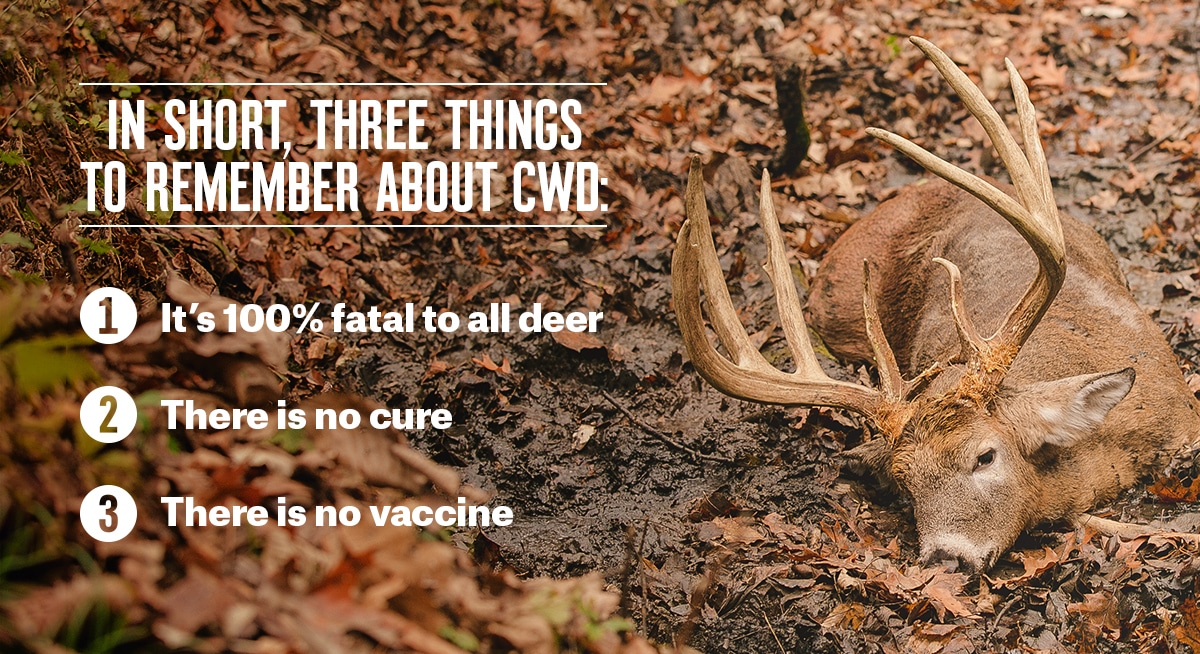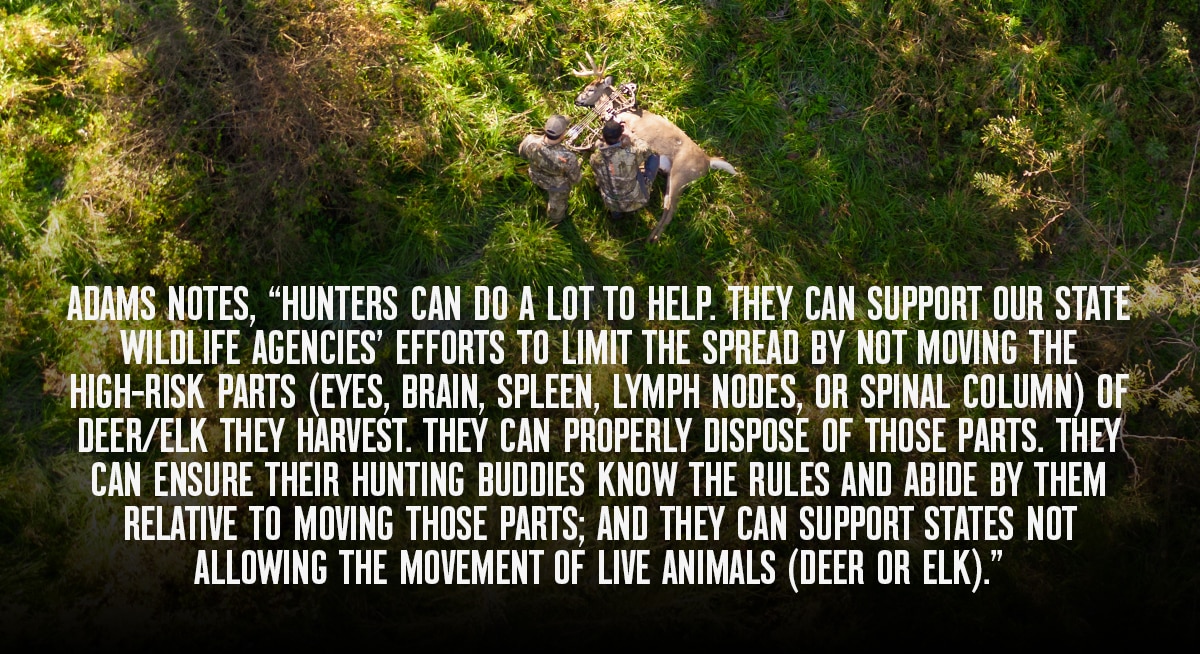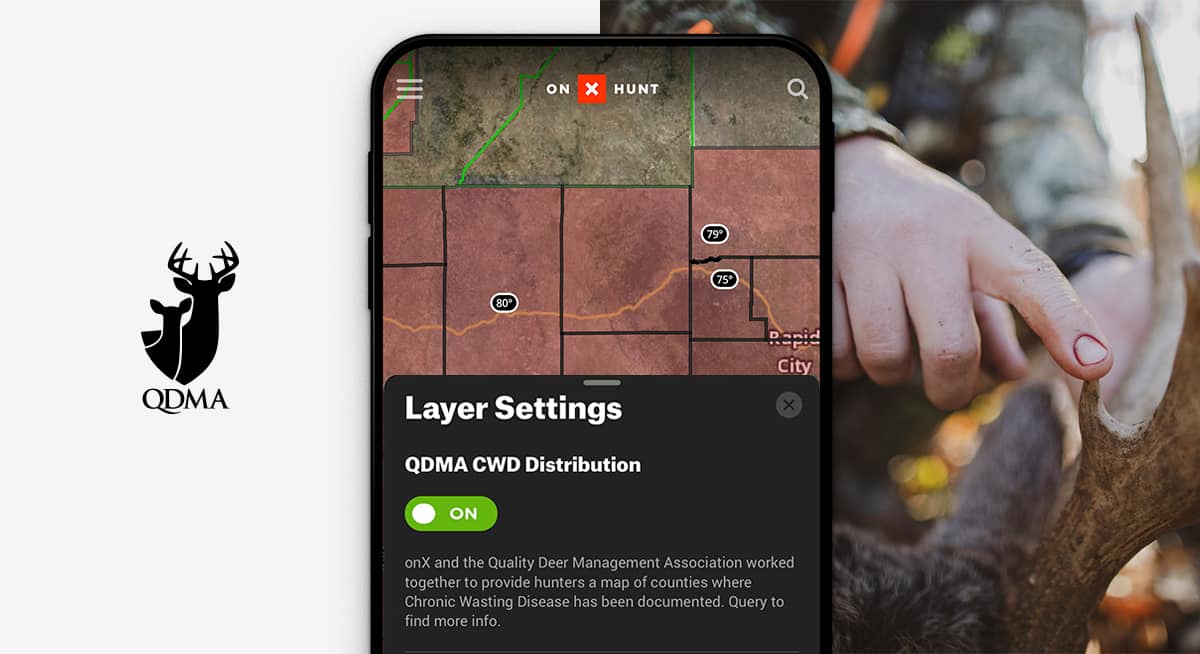As we all enter our respective hunting seasons, it’s inevitable that chronic wasting disease (CWD) will be on the minds of hunters around the country.
Maybe you hunt in a known CWD area and wonder if the meat you harvest is safe to feed your family. You could be traveling to a new area to hunt, one with positive CWD cases, and wondering how you should change your field procedures. Or maybe, like many of us at the onX office here in Montana, you’re watching more and more counties test positive for CWD and realizing you’ll need to reconsider your hunting routine.
In a past CWD blog post, we covered what you need to know if you’re hunting in a known CWD area. If you need a refresher on what CWD is—beyond something that seemingly complicates your hunting process—here’s a reminder:
A neurodegenerative disease resulting in abnormal behavior, loss of body condition, and eventual death, CWD is a prion disease with a non-living vector. Prions are an abnormal form of a typically-harmless protein found in the brain and are responsible for a variety of neurodegenerative diseases in both animals and humans. These diseases occur when normal protein folds and “clumps” in the brain, causing brain damage. Scientists are still uncertain what causes the clumping, and the disease is almost impossible to test for in living animals; many diseased cervids (members of the deer family) may show no signs of the disease for several years yet still actively be spreading CWD.
Transmission of CWD is thought to be lateral—passed from animal to animal, not from mother to fetus—and can occur through direct contact via saliva, blood, urine, and feces, or indirectly through the environment: water, food, and even the soil.
In short, here are three things to remember about CWD:
- It’s 100% fatal to all deer.
- There is no cure.
- There is no vaccine.
Remember: a deer can be perfectly healthy and still be CWD positive.

The National Deer Association team, based in Bogart, Georgia, is constantly hard at work on this complex issue and continues to confirm new cases in hunting areas that had previously demonstrated negative CWD presence.
Kip Adams, NDA’s Director of Conservation, notes 2020 is presenting unique challenges in the battle against CWD.
“Unfortunately CWD isn’t following the social distancing guidelines and continues expanding to new areas,” Adams comments. “Pennsylvania and other states have published new CWD plans. Due to budget and personnel issues Michigan DNR is cutting back on CWD testing this fall, and we are working with Pennsylvania and Michigan state wildlife agencies on CWD messaging and hunter behavior projects.”
While state agencies face struggles this fall, it’s imperative hunters step up to the plate to help prevent the continued spread of CWD. Landowners, too, can do their share.
Doug Duren, MeatEater Contributor and a Midwest landowner himself, is taking proactive steps to navigate CWD.
“Our farm is in the CWD area of southwest Wisconsin,” Duren shares. “CWD has changed a number of things in our hunting season routine. We focus on healthy deer management rather than higher numbers, quality, or trophy deer management. In our area that means controlling population by taking more antlerless deer and encouraging filling your buck tag. The only rule on our farm is to take a good ethical shot. That does not mean that a hunter can’t choose to let a doe or buck pass, but if you’re hunting with us, we want to see those tags filled. We include sleeves and gutting gloves in our hunting kits and use them during field dressing to avoid possible exposure to CWD prions. We also encourage everyone to get their deer tested (I require that all deer killed on our farm are tested) to provide more data to help understand the spread and prevalence of the disease and so hunters can make an informed decision about eating meat from a deer that has CWD.”
Hunters and landowners alike can contribute to help mitigate the spread of CWD.

Adams notes, “Hunters can do a lot to help. They can support our state wildlife agencies’ efforts to limit the spread by not moving the high-risk parts (eyes, brain, spleen, lymph nodes, or spinal column) of deer/elk they harvest. They can properly dispose of those parts. They can ensure their hunting buddies know the rules and abide by them relative to moving those parts; and they can support states not allowing the movement of live animals (deer or elk).
The answer isn’t to stop hunting. Duren adds, “Hunters and landowners: Keep hunting deer! Help control the population and demographics that spread the disease. Don’t transport carcasses out of a CWD area. Dispose of your deboned carcass properly. Wisconsin has implemented a carcass disposal program that provides dumpsters where hunters can dispose of their carcasses properly.”
We can expect to see more state-implemented testing in the future. Duran notes that Wisconsin has an “Adopt a Kiosk” program, and encourages landowners to provide space for a testing kiosk and to allow more access for responsible hunters who can help control deer populations.
So what are the rules? How can you be a responsible hunter this season?
If you’re hunting in a known CWD area, Adams recommends hunters check the state wildlife agency’s guidelines to ensure they know what is required from a reporting and/or testing standpoint. Hunters should also follow the CDC and World Health Organization’s recommendations to not eat a deer/elk from a CWD zone until they receive a satisfactory CWD test.
“If hunters aren’t sure if they’re hunting in a zone that has confirmed CWD they should (obviously) check the CWD Map Layer on their onX Hunt App!” he adds.
Duren notes that controlling the spread and prevalence of CWD is vitally important.
“Help with these simple ideas: If CWD is not present in the area where you’re from, don’t take it back with you,” he recommends. “Where it is present, help with the effort to control prevalence. If you don’t have it in your area, you don’t want it. If it does exist in your area, you want as little as possible. Act accordingly and follow guidelines from your Department of Natural Resources and groups like CWD-info.org, the National Deer Alliance, USGS Wildlife Health Center, and Quality Deer Management Association.”
What if you’re hunting an area with no reported cases? Adams advises caution is key: “Hunters should still check with the state wildlife agency to ensure they’re not being asked to provide a sample for testing, but they don’t need to have their animal tested prior to consuming it. However, they should report any sick animals they see to the state wildlife agency. The vast majority of CWD-positive deer do NOT show any visible signs of the disease (they don’t look sick), but it’s always good for hunters to keep an eye out for sick animals and report them.”
CWD check station locations can be found by contacting your state fish and wildlife regional offices. Some states, such as Michigan, have an online map detailing check stand locations—a quick web search will often provide the locations of drop boxes, testing sites, and check stations in your hunting area. For the actual testing process, the head with the upper portion of the neck (one or two vertebrae) attached is needed; the head should not be frozen or rotten.

The CWD Map Layer in the onX Hunt App that Kip mentioned has been designed to help hunters identify where CWD is present. This layer is updated as the NDA team confirms new counties and shares that data with onX, ensuring you have the most up-to-date information in your hands.
The NDA team has also compiled a large amount of information on the disease and how it applies to hunters, herd management techniques, and conservation.
Research is active and ongoing. Most recently, the NDA is working with the CWD Alliance and the National Prion Disease Pathology Surveillance Center at Case Western Reserve University on research projects to increase our knowledge of CWD and enhance our management options.
So what does the future look like for CWD? Adams is pragmatic about the coming years, noting, “I think it’s going to continue spreading, but we learn more about it every day. We simply need to limit its spread while science gives us a better way to combat it. At some point we will determine how to beat it, and it will benefit us greatly if we limit its spread right now so it’s easier to administer the solution once we find it.”
Duren agrees, adding, “Unfortunately, I think CWD will continue to spread. But we should work to slow that spread to new areas and reduce prevalence where CWD does exist. We should work hard to manage the disease.” What can hunters do to help? “Simply put: Buy time and pay for science. Hunt deer, get it tested and encourage—even demand—that your state and federal government and agencies provide more funding for education and research for universities.”